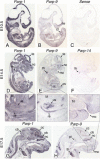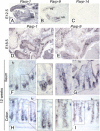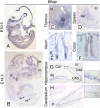The macroPARP genes Parp-9 and Parp-14 are developmentally and differentially regulated in mouse tissues
- PMID: 18069692
- PMCID: PMC7163462
- DOI: 10.1002/dvdy.21399
The macroPARP genes Parp-9 and Parp-14 are developmentally and differentially regulated in mouse tissues
Abstract
The macroPARPs Parp-9 and Parp-14 are macro domain containing poly(ADP-ribose) polymerases involved in transcriptional regulation in response to immunoregulatory cytokines. Their genes reside in the same locus (16B3), and the Parp-9 gene lies head-to-head and shares its promoter with the gene encoding its partner, Bbap. Here, we provide a detailed analysis of Parp-9, Parp-14, and Bbap expression during mouse development and adulthood. Parp-9 is developmentally regulated, and prominently expressed in the thymus and specific regions of the brain and gut. In adults, highest expression is maintained in the thymus and intestine. Parp-14 is more weakly expressed, mainly in the thymus during development and in adulthood. In addition, we show that Bbap is essentially coexpressed with Parp-9 during development and in adult mouse. However, the different levels of their transcripts detected in the developing brain and gut suggest that Bbap and Parp-9 display both common and independent tissue-specific regulations.
Figures





Similar articles
-
Cloning and expression of PARP-3 (Adprt3) and U3-55k, two genes closely linked on mouse chromosome 9.Folia Biol (Praha). 2002;48(5):182-91. Folia Biol (Praha). 2002. PMID: 12448766
-
Poly(adp-ribose) polymerase-1 regulates Tracp gene promoter activity during RANKL-induced osteoclastogenesis.J Bone Miner Res. 2008 Apr;23(4):564-71. doi: 10.1359/jbmr.071111. J Bone Miner Res. 2008. PMID: 18021007
-
A bidirectional promoter connects the poly(ADP-ribose) polymerase 2 (PARP-2) gene to the gene for RNase P RNA. structure and expression of the mouse PARP-2 gene.J Biol Chem. 2001 Apr 6;276(14):11092-9. doi: 10.1074/jbc.M007870200. Epub 2000 Dec 22. J Biol Chem. 2001. PMID: 11133988
-
Genomic organization of Drosophila poly(ADP-ribose) polymerase and distribution of its mRNA during development.J Biol Chem. 1998 May 8;273(19):11881-6. doi: 10.1074/jbc.273.19.11881. J Biol Chem. 1998. PMID: 9565614
-
The Role of PARP-1 in Host-Pathogen Interaction and Cellular Stress Responses.Crit Rev Eukaryot Gene Expr. 2015;25(2):175-90. doi: 10.1615/critreveukaryotgeneexpr.2015013626. Crit Rev Eukaryot Gene Expr. 2015. PMID: 26080611 Review.
Cited by
-
Late multiple organ surge in interferon-regulated target genes characterizes staphylococcal enterotoxin B lethality.PLoS One. 2014 Feb 13;9(2):e88756. doi: 10.1371/journal.pone.0088756. eCollection 2014. PLoS One. 2014. PMID: 24551153 Free PMC article.
-
PRMT1 arginine methyltransferase accumulates in cytoplasmic bodies that respond to selective inhibition and DNA damage.Eur J Histochem. 2014 May 2;58(2):2389. doi: 10.4081/ejh.2014.2389. Eur J Histochem. 2014. PMID: 24998928 Free PMC article.
-
Deltex-3-like (DTX3L) stimulates metastasis of melanoma through FAK/PI3K/AKT but not MEK/ERK pathway.Oncotarget. 2015 Jun 10;6(16):14290-9. doi: 10.18632/oncotarget.3742. Oncotarget. 2015. PMID: 26033450 Free PMC article.
-
Brain tissue transcriptomic analysis of SIV-infected macaques identifies several altered metabolic pathways linked to neuropathogenesis and poly (ADP-ribose) polymerases (PARPs) as potential therapeutic targets.J Neurovirol. 2021 Feb;27(1):101-115. doi: 10.1007/s13365-020-00927-z. Epub 2021 Jan 6. J Neurovirol. 2021. PMID: 33405206 Free PMC article.
-
Functions and Molecular Mechanisms of Deltex Family Ubiquitin E3 Ligases in Development and Disease.Front Cell Dev Biol. 2021 Aug 25;9:706997. doi: 10.3389/fcell.2021.706997. eCollection 2021. Front Cell Dev Biol. 2021. PMID: 34513839 Free PMC article. Review.
References
-
- Aguiar RC, Yakushijin Y, Kharbanda S, Salgia R, Fletcher JA, Shipp MA. 2000. BAL is a novel risk‐related gene in diffuse large B‐cell lymphomas that enhances cellular migration. Blood 96: 4328–4334. - PubMed
-
- Aguiar RC, Takeyama K, He C, Kreinbrink K, Shipp M. 2005. B‐aggressive lymphoma (BAL) family proteins have unique domains that modulate transcription and exhibit Poly(ADP‐ribose) polymerase activity. J Biol Chem 280: 33756–33765. - PubMed
-
- Amé JC, Spenlehauer C, de Murcia G. 2004. The PARP superfamily. Bioessays 26: 882–893. - PubMed
-
- Angelov D, Molla A, Perche PY, Hans F, Cote J, Khochbin S, Bouvet P, Dimitrov S. 2003. The histone variant macroH2A interferes with transcription factor binding and SWI/SNF nucleosome remodeling. Mol Cell 11: 1033–1041. - PubMed
-
- Artavanis‐Tsakonas S, Rand MD, Lake RJ. 1999. Notch signaling: cell fate control and signal integration in development. Science 284: 770–776. - PubMed
Publication types
MeSH terms
Substances
LinkOut - more resources
Full Text Sources
Other Literature Sources
Molecular Biology Databases

